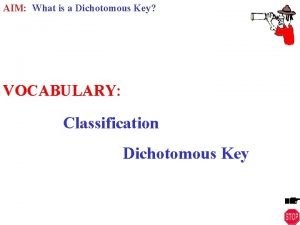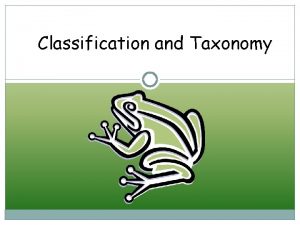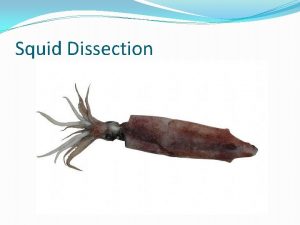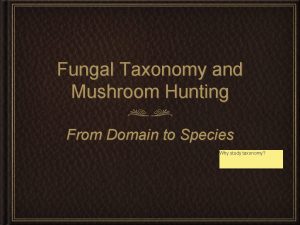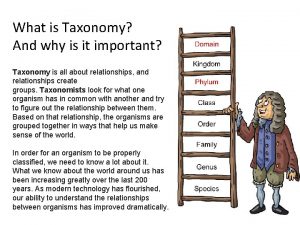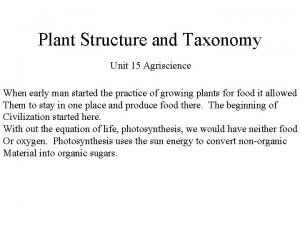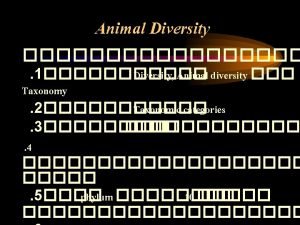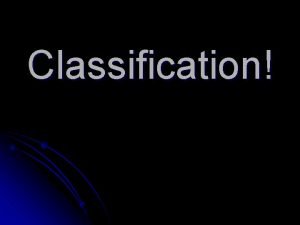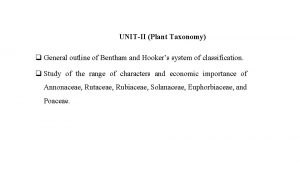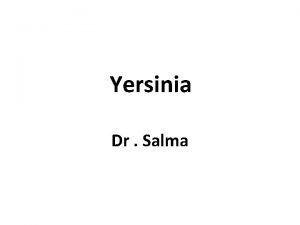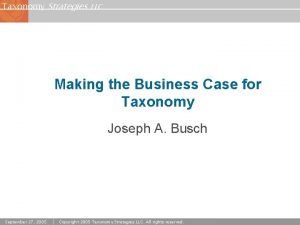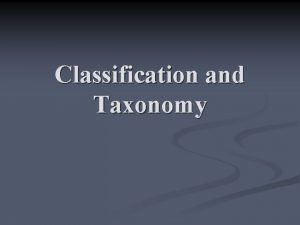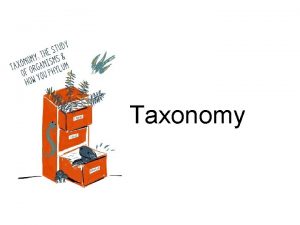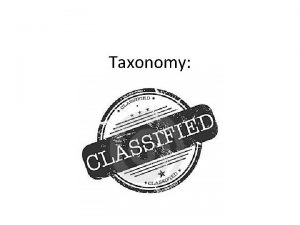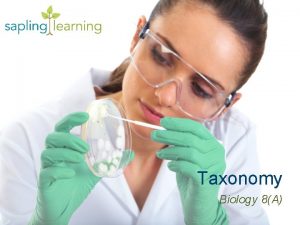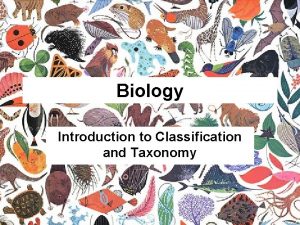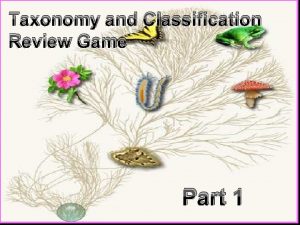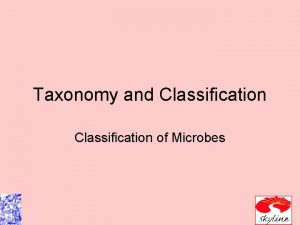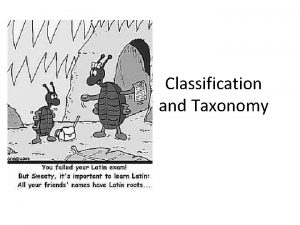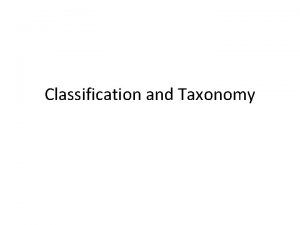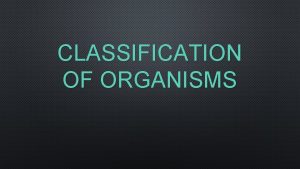Classification Taxonomy Classification and Taxonomy Classification process of



















- Slides: 19

Classification & Taxonomy

Classification and Taxonomy Classification- process of dividing organisms into groups with similar characteristics Taxonomy- the science of classifying living things Taxon- any particular group within a taxonomic system

Dichotomous Key Dichotomous Key- tool used to identify organisms using their characteristics Characteristics Read are given in pairs both characteristics and either go to another set of characteristics or identify the organism

Magnolia Elm Walnut Spruce Pine White Oak Chestnut Holly

Development of Taxonomy A natural way of classifying organisms is based on the way organisms look and how they live About 2, 400 years ago, Aristotle classified organisms into only two taxa-plants or animals Swedish botanist Carolus Linnaeus developed a classification system based on structural similarities during the 1700’s

Development of Taxonomy Linnaeus divided all organisms into two major groups called Kingdoms, which he divided into smaller and smaller groups Less Specific More Specific

Development of Taxonomy Domain- largest division of taxonomy, based on differences between prokaryotes and eukaryotes, ex. Eukarya Kingdom- second highest taxonomic rank below domain, ex. Animalia Species- organism that are similar in structure and appearance, can breed successfully, and have the same number of chromosomes, ex. Sapien Varieties or breeds- groups of slightly different organisms in the same species, ex. Golden retriever


Binomial Nomenclature Linnaeus also introduced a system of naming organism called Binomial nomenclature. In binomial nomenclature the first name is the genus to which the organism belongs, the second name is the species name of that organism. The GENUS name is capitalized; the species name is lower case. Scientific names are always underlined or italicized. Ex. Homo sapien

Binomial Nomenclature Linnaeus used Latin names because: It is the language of scientists around the world It is studied and written, but not spoken It is descriptive and the root of many other languages Examples of scientific names: Canis familiaris domestic dog Canis lupus wolf Canis latrans coyote

Which two are most closely related? Polar Bear Ursus maritimus Grizzly Bear Ursus arctos Giant Panda Ailuropoda melanoleuca

Common Names Common names are confusing because: The same organism may have many common names. Ex. Felis concolor, common namecougar, mountain lion, puma, panther Common names are misleading. Ex. A jellyfish is not a fish, but a seahorse is a fish Common names vary with different languages. Ex. Chipmunk- Streifenhörnchen (German), Ardilla (Spanish), 花栗鼠 (Chinese)

Modern Taxonomy Modern taxonomy is based on genetic similarities and theory of evolution. If two organism have the same number of chromosomes and the chromosomes are similar in form, then the organism are closely related. The greater similarities in DNA, the closer the relationship between organisms.

Three Domains 1. Domain Archea- (Kingdom Archeabacteria) prokaryotic organisms that live in extreme environments; halophiles (organism which thrive in highly salty environments), and hyperthermophiles (organism which thrive in extremely hot environments) are examples 2. Domain Bacteria- (Kingdom Eubacteria) common prokaryotic organism found almost everywhere; bacteria (heterotrophic carbon-eating prokaryotes) and cyanobacteria (autotrophic photosynthetic prokaryotes) 3. Domain Eukaryote- eukaryotic organism that are most of the world’s visible living things; kingdoms Protista, Fungi, Plantae, and Animalia are examples


Four Kingdoms of Domain Eukaryota Kingdom Protista- eukaryotic unicellular organism (cells have nucleus); protozoa and simple algae Kingdom Fungi- multicellular eukaryotic organism that are plant like in structure but cannot make their own food; molds and mushrooms Kingdom Plantae- multicellular eukaryotic organism which can make their own food through photosynthesis; plants Kingdom Animalia- mobile, multicellular, eukaryotic organisms that ingest food; sponges, worms, fish, reptiles, birds, mammals


Phylogenetic Trees and Cladograms Phylogeny- the study of evolutionary relationships or ancestral relationships among organism Phylogenetic tree- a diagram showing how species are related to each other through common ancestors Phylogenetic trees show which organism are extinct and which are still living. It also gives the relative times when the organism were alive.

Cladograms Cladograms- a diagram that depicts the degree of evolutionary relationships among organism, based on related structures and adaptations Derived characteristics appear at branches of the cladogram showing where they first arose. Cladograms DO NOT show the relative times that organism lived and do not show common ancestors.
 Marzano taxonomy chart
Marzano taxonomy chart Dichotomous key list
Dichotomous key list What is a dichotomous key? *
What is a dichotomous key? * Broadest level of classification
Broadest level of classification Horse taxonomy classification
Horse taxonomy classification Phylum squid
Phylum squid Mushroom taxonomy classification
Mushroom taxonomy classification Os coxae
Os coxae Condylar and coronoid process of mandible
Condylar and coronoid process of mandible Dumbking plant
Dumbking plant Unit 15 plant structures and taxonomy
Unit 15 plant structures and taxonomy The taxonomy of the domestic dog and humans
The taxonomy of the domestic dog and humans Cell structure and taxonomy
Cell structure and taxonomy Taxonomy and taxidermy
Taxonomy and taxidermy In the hierarchy of classification which grouping
In the hierarchy of classification which grouping Annona squamosa floral formula
Annona squamosa floral formula Metadata and taxonomy
Metadata and taxonomy Bubonic plague
Bubonic plague Metadata taxonomy
Metadata taxonomy Liberty chapter 20
Liberty chapter 20


